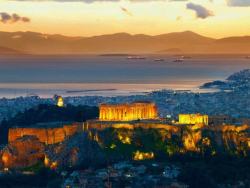Caves of Acropolis

Caves of Acropolis
Also on the northwestern side of the Acropolis Hill, there is a carving in the rock and stairs leading to the ancient and sacred Klepsydra Spring. The Sanctuary of Zeus Olympios is the largest of the 3 caves, situated between the Cave of Pan and the Cave of Apollo. Excavations carried out by the Archaeological Society in 1983 discovered a marble column and an inscription dating back to 250 B.C.
Pan's cave is a small labyrinth of arches and passages with 3 parts situated above the Klepsydra Spring. The east section was converted to a chapel dedicated to Agios Athanasios in the 5th Century A.D. The cave of Apollo is found below the north wall of the Acropolis and, as suggested by the niches with votive inscriptions, was probably in use since the 13th Century B.C. Excavations in the cave revealed 68 inscribed votive plaques dedicated to Apollo. Further to the east, Eros and Aphrodite had an open-air sanctuary.
Other natural caves and shrines are found on the northwestern side of the Acropolis, but they are not accessible to the public and are not yet explored and identified. The cave shrines of the Acropolis can be visited by walking along the "Peripatos", the ancient circuit path around the sacred rock.





